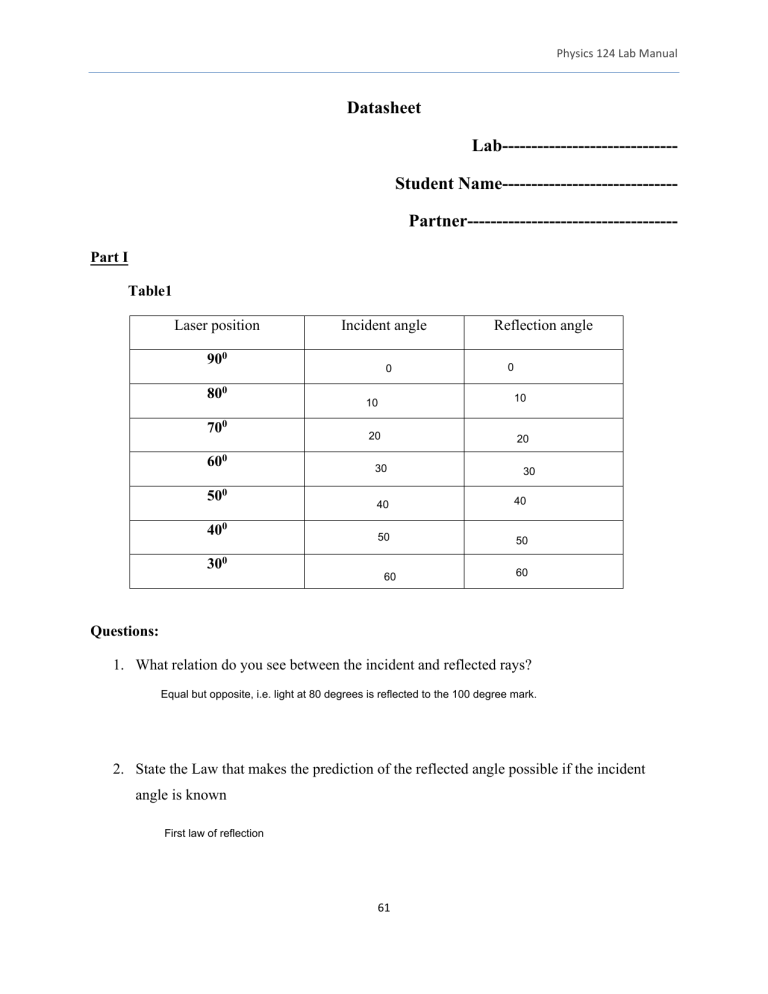
Physics 124 Lab Manual Datasheet Lab-----------------------------Student Name-----------------------------Partner-----------------------------------Part I Table1 Laser position Incident angle 900 800 700 600 500 400 0 Reflection angle 0 10 10 20 20 30 30 40 40 50 50 300 60 60 Questions: 1. What relation do you see between the incident and reflected rays? Equal but opposite, i.e. light at 80 degrees is reflected to the 100 degree mark. 2. State the Law that makes the prediction of the reflected angle possible if the incident angle is known First law of reflection 61 Physics 124 Lab Manual Part IA Questions: 3. Where do the lines meet? 1 1/2 in behind mirror, 2 1/4 in from obj to mirorr 4. Write rules you could use to predict the location of the image if you had no mirror or pins; just the original sheet of paper you were given. The distance from the object to the mirror can be determined by drawing a line between two objects that block the visual path of the original and finding their intersection. Part IB Questions: 5. How many images do you see? 90 deg: 3 images 45 degrees: 7 images 6. Write rules for locating all the images. # of images = 360/angle -1 7. Explain why all the images are there. Law of reflection 8. Is there a way to get more images with the two mirrors? Make angle smaller 62 Physics 124 Lab Manual 9. Explain the path of the light ray from the pin to the mirror and to the eye in all of the experiments you have done. Source of light -> object -> mirror -> reflected to viewer's eye. Part IIA: Refraction Glass Prism Table2 Glass Prism Θ1(0) Θ2 (0) Θ3(0) 16 20 Θ4(0) 16 20 30 22 40 29 50 35 60 41 30 22 29 40 50 35 60 41 sinθ1 0.34 0.5 0.64 0.77 0.87 Question: 10. How do the four angles compare to each other for each experiment? Angle 1 and 4 = 1.25 * angle 2 and 3 63 sinθ2 0.28 0.37 0.48 0.57 0.66 Physics 124 Lab Manual Part IIB: Refraction Plastic Prism Table 3 Plastic Prism Θ1(0) Θ2 (0) 20 30 Θ3(0) 6 6 12 12 40 15 50 21 60 Θ4(0) 24 sinθ1 20 30 0.34 0.5 15 40 0.64 21 50 0.77 60 0.87 24 sinθ2 0.104 0.207 0.258 0.358 0.406 Questions: 11. Do you find the same relationship when you compare the angles for the plastic prism? No, angle 1 and 4 = 2.5 * angle 2 and 3 12. Plot a graph of sin θ1 versus sin θ2 and determine the slope for both the glass and the plastic prisms 13. What is the significance of the slope of the graphs? It is the refractive index of the materials 64 Physics 124 Lab Manual 14. How do the slopes for glass and the prism compare? Glass has a larger slope than plastic 15. How does Ө2, Ө 3, and Ө4 of the glass prism compare to Ө 2, Ө 3, Ө4, of the plastic prism? There is generally a larger difference between the angles in plastic than in glass. 16. What can you infer about how light travels through different materials? Light travels slower through glass than plastic 17. Using your observations, can you write an equation that describes the relationships of these angles? Glass: angle 1 = angle 4; angle 2 = angle 3; angle 1 or 4 = 1.5 * angle 2 or 3 Plastic: angle 1 = angle 4; angle 2 = angle 3; angle 1 or 4 = 2.5 * angle 2 or 3 18. From your analysis describe in detail what you can infer about the behavior of light as it is reflected and refracted. Light slows when it is refracted, or perhaps more precisely, refraction is the result of light slowing. Reflection sends light in an equal but opposite angle from the angle of incidence. When light is reflected it continues at the same speed. Submit all work / drawings along with the datasheet to your TA 65



